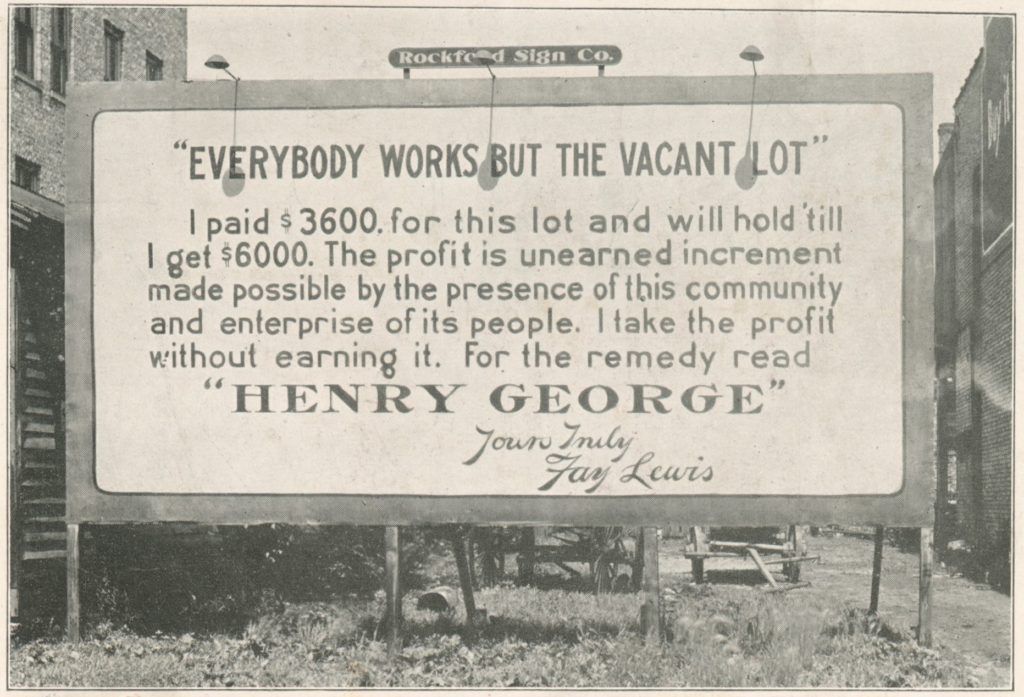PERSPECTIVE | Mayor Robert Garcia Quit the Young Republican Club, but Kept the Libertarian Housing Policies
37 minute readLong Beach Mayor Robert Garcia announced in late December that he’s running for Congress. If he wins, his office will represent the new 42nd District, encompassing several southeastern Los Angeles cities, as well as parts of Long Beach.
The first thing news outlets want you to know about his candidacy is that during the 2000 election, Garcia was a founding member of the Young Republican Club at Cal State Long Beach, and campaigned for George Bush. A neglected piece of this history, however, is that he was also the Communications Director of the Nixon Presidential Library, and after graduating college he founded another Republican club: The Long Beach Young Republicans. As reported by Bill Pearl of LBReport.com, when the club was just getting started in 2005, Garcia exclaimed: “It’s going to be huge. I honestly believe that within a year or two, this is going to be the most influential Republican organization in the city.”
As important as this information is, providing it in isolation—without any recent context—could give voters the impression that being a Republican 17 years ago is the biggest scandal of Garcia’s career. Something he’ll have to fight to overcome. But that narrative is the equivalent of letting Garcia go bowling with bumper lanes—the bumpers aren’t an obstacle in the way of his goal, but a boundary that limits what could possibly go wrong while increasing the chances of success.
The last time his Republican past was an issue, it was 2014, and he was running to be the mayor of Long Beach. When the Orange County Register spoke with him about his campaign, they uncovered more than one instance of deceit.
First, Garcia tried to let on that he wasn’t that involved in the Republican Party, even describing himself as “apolitical.” The OC Register responded with facts, claiming Garcia “initially didn’t tell the truth in an interview.”
They found that Garcia was the California youth coalition coordinator for the George Bush campaign—a role he managed to get “after walking into Republican offices and writing to the campaign’s national headquarters.” The OC Register continued:
“He stayed in the party as it championed other causes that he said he now opposes. There were the repeated anti-same-sex marriage efforts, the repeated anti-abortion efforts, and repeated voter identification efforts. He also founded the Long Beach Young Republicans and worked on Republican Frank Colonna’s campaign for mayor.
Garcia would become a Democrat around the time that he moved to District 1, one of the more liberal parts of the city, from the 3rd, one of the more conservative parts. Shortly thereafter, he ran for City Council in 2009 and won.”
They also reported that while Garcia’s opponent in the 2014 mayoral race, Damon Dunn, refused to use Garcia’s Republican past against him, Garcia didn’t offer Dunn the same respect:
“Though both candidates share a similar history, Garcia and his campaign are using email and mailers to try to turn Dunn’s political past into baggage, a play that Dunn hasn’t used in turn. Garcia’s efforts rely on statements Dunn made during his 2010 run for secretary of state and are being used to depict Dunn as a Tea Party ‘right-wing extremist’ …. Garcia also has attacked Dunn for embracing policies that the GOP fought for while Garcia himself was one of the party’s members and actively involved in its local leadership and political campaigns.”
The deeper you look into Garcia, the more you find hidden caverns of hypocrisy. Though his founding of multiple Young Republican Clubs, and his formative soft spot for President Ronald Reagan, wouldn’t be such big problems if they were truly behind him, they become crucial flaws when he continues telling the same lie to obscure the same simple truth. It’s what he lied to the OC Register about in 2014; it’s what he lied to readers about when we caught him red-handed on the wrong side of Black Lives Matter in 2020; it’s what he lied to the public about later that year when he was faced with a recall campaign and made up housing numbers; it’s what he lied about in his 2022 State of the City address when he claimed “nothing is more important” than “preventing unjust evictions.” It’s what he’s still—all these years later—trying to hide:
Garcia’s political allegiances are not with the working classes, immigrants, Latinos, renters, or any other marginalized group he’ll likely be name-dropping during his run for Congress. His commitments are first to himself, second to whoever is rich or powerful enough to help his career, and third to his poorly-thought-out-yet-deeply-held libertarianism. One full decade of his housing policies is all the proof you need of that.
FROM YOUNG REPUBLICAN TO MIDDLE-AGED LIBERTARIAN
Long Beach’s mayor has a long history of advocating for market-based exploitations of the housing crisis. His record clearly shows that he has fought to let developers build whatever type of housing they want in the city, but has not fought for affordability provisions, renter protections, or rent control.
Though Garcia’s authority as mayor is not inherently legislative, he still has tremendous power within the city to set boundaries for what is, and isn’t, politically possible. His rhetoric—both publicly, and within closed-door city meetings—can influence or even dictate the direction of future policy, even if he never authors or votes on it himself. And, of course, with Garcia running for Congress, he could soon become a policy-maker, too. All this makes his words, and their impacts, fundamentally important.
For starters, Garcia is—and always has been—resolutely opposed to the one housing policy we know keeps people in their homes: rent control.
Though rent control is not perfect, and is not on its own a solution, it can and should be part of the toolkit for addressing the housing crisis—especially since it does, in fact, reduce displacement. Even studies critical of the policy have noted this.
On top of that, it can help keep prices down. A large study looking at 18 developed economies over four decades found that “stringent rent control regimes” lead to “lower real rent growth rates than regimes with free rents.” That mirrors what another study found when Cambridge, Massachussettes suddenly removed stringent rent control in 1995, and prices soared:
“… we find that rent decontrol generated substantial, robust price appreciation … accounting for a quarter of the $7.8 billion in Cambridge residential property appreciation…”
The problems with rent control, however, are also worth mentioning—even if they are found too-easily on the lips of the real estate industry: A study looking at San Francisco’s 1994 rent control law found it decreased renter mobility by 20% (meaning renters who benefitted from the policy were subsequently more likely to be stuck in their homes), and it reduced “rental housing supplies by 15 percent.”
Still, being stuck in your home is a far cry from being stuck outside it—and rent control only promises to do one of these things. Moreover, a dwindling supply of rental units appears to be less a problem of policy, and more a problem of enforcement:
“According to the Stanford study, 15 percent of the units in certain smaller buildings in San Francisco have been ‘converted’ to market-rate since voters placed these buildings under the city’s rent control law through a 1994 ballot measure. That unremarkable finding simply highlights what tenant advocates have been trying to stop for years—speculation that skirts rent control by converting units.”
While separating policy from enforcement—let alone ensuring the high quality of each—would no doubt be difficult, taking all forms of rent control off the table entirely is just reactionary. It speaks more to a battle for donors than for justice. In 2018, it was reported by the Long Beach Business Journal that when Garcia first took office as mayor in 2014, he had already confirmed to a real estate special interest group that he was opposed to rent control.
That’s not progressive, or innovative, or even moderate. It’s conservative, close-minded, and politically expedient. It’s Garcia making a campaign promise so he can gather campaign donors. After all, the same San Francisco study that was critical of rent control found, none-the-less, that it financially benefited renters at the direct expense of the real estate industry, to the tune of $7 billion, and more:
“The $7 billion savings for tenants is the tip of the iceberg, relating only to the studied group—tenants in small buildings who lived in their homes in 1994 when they became rent controlled. As the authors note, it does not measure the benefit for all of the tenants who moved into the studied properties after they gained rent control.”
That’s rent control working—doing exactly what it’s supposed to do: Convert some of the high costs of housing into savings for renters.
Garcia has opted instead to preserve and enhance real estate industry profits, at the direct expense of renters—who make up 60% of Long Beach households. In 2012, the city passed a major development initiative for the downtown area and, despite warnings of mass displacement, Garcia fought against adding affordability provisions. Other councilmembers tried to introduce inclusionary zoning to the plan, but Garcia’s motion to pass the plan without such provisions won out.
At the time, it was estimated that nearly 24,000 low-income residents in the downtown area would be at risk of displacement, (pg. 1) and would have a “serious challenge” finding affordable homes.
Twenty four thousand human beings at risk of displacement. Garcia didn’t blink.
The Downtown Plan streamlined approval for new development in Long Beach’s downtown area, and in the years that followed, as rents spiked and displacement continued, Garcia never helped in the fight for even the most basic of renter protections. I remember seeing, in-person, the struggle for just-cause eviction die in a small room at a commission meeting in 2018, back when local elected leaders, like Garcia, wouldn’t offer their support. It never even made it to council for a vote.
As outlined in a 10-year look-back at the Downtown Plan recently published on our site, it took years—and some leadership at the state level—for Long Beach to catch up:
“It wasn’t until 2019—when the state was poised to cap rent increases and enact eviction protections, and seven years after the Downtown Plan—that Long Beach finally sprung into action and passed a tenant relocation assistance ordinance. And while inclusionary zoning was shot down the night the Downtown Plan was certified, it was eventually passed in 2020.”
By 2020, eight years after the Downtown Plan was passed, and two years into Garcia’s second term as mayor, the damage to the downtown area had already been done. Our look-back at the Downtown Plan summarized some of the changes:
“Between 2010 and 2020, the 90802 zip code, which encompasses much of the city’s urban core, saw rents shoot up by 32%, the highest increase of any Long Beach zip code, according to the city’s latest proposed Housing Element. The document also states that wages in Long Beach have actually decreased during that same 10-year span, making housing less attainable than ever. Last year, the average rent in 90802 reached $2,001. According to the most recent Downtown Long Beach Alliance Market Survey, 1,673 new residential units have been built in 13 downtown developments since 2012, none of which are affordable housing projects.”
[READ: The Downtown Plan: 10 Years of Rent Hikes & Displacements]
Somehow, the facts of his neglect haven’t stopped Garcia from bragging on camera about renter advocacy, erecting for himself the public image of a working-class hero. In his recent State of the City address, he boldly claimed, “Nothing is more important than … preventing unjust evictions.”
Shameless. While hard-working, sometimes undocumented, housing activists struggled for years—unheard and unsupported—to defend their homes, Garcia was appearing in national outlets, such as the New York Times, to cheer on Long Beach’s irresponsible development. At one point shortly after his re-election to mayor in 2018, Garcia said to developers: “We’ve got the welcome mat out.”
This was 13 years after he founded the Young Republican Club.
TRICKLE-DOWN MAGIC
Perhaps most disastrously, though, he has adopted for Long Beach the terrible idea of “filtering”—i.e., “trickle-down housing,” or, as the OC Weekly put it:
“Garcia’s housing policy openly adheres to the ‘filtering theory,’ which is akin to the trickle-down economic theory infamously promoted by President Ronald Reagan in the 1980s and has been more recently endorsed by Trump and the Tea Party wing of the Republican Party.”
Garcia claims his Reagan days are behind him, and yet he doesn’t seem done playing around with Reaganomics.
So what exactly is “filtering”? As a writer with Forbes informs us in an article titled, “What Liberals Don’t Get About Affordable Housing”:
“Filtering is the idea that, as new market-rate housing is built, higher-income people move into it, leaving behind older housing stock for lower-income people.”
How considerate.
And what is “market-rate” housing? It’s just any housing that isn’t income restricted. It’s what developers build when left to build what they want, without having to worry about affordability standards. Whatever they believe the market in an area will get them, they can charge that price, and that’s “market-rate.” Even luxury units are counted as “market-rate.” Long Beach’s new $15,000-a-month, two-story penthouses are considered “market-rate.”
What did one of the developers of that particular project have to say about building a luxury high-rise in one of the most overcrowded, rent-burdened parts of the country?
“I think one of the most disappointing things I heard while we were developing this project was that, ‘You don’t have to go that nice for Long Beach,'” [the developer] said. “And I found that frustrating because we’re talking about people—all kinds of people—and there are people who appreciate high-quality housing that pays attention to detail.”
Downtown’s currently-under-construction, $215 million Broadway Block project is similarly composed of nothing but market-rate units—including many luxury penthouses which will be dotted throughout its high-rise tower. When I covered the project’s tragic history—full of many bad actors and bad decisions—I wrote:
“The [Broadway Block’s] new owner, Onni, has already come under scrutiny for building so much in Downtown Los Angeles without including any affordable units. But it’s not as if the previous owner was building affordable units anywhere, either. Ratkovich Properties had already developed the Edison in Long Beach, for instance, which is described on the project’s website as consisting of ‘156 luxury flats.’”
[READ: “Restore the Facade”: Gentrification and Downtown’s New $215 Million Luxury High-Rise]
All of these projects are market-rate, and it’s important to keep in mind that they embody a tangible cost: Every market-rate project takes up physical space that could have gone to an affordable project. One of our journalists, Kevin Flores, discovered through a public records request that the Broadway Block site had received multiple bids, including one from an affordable developer. But the city approved the luxury high-rise instead.
So if “market-rate” includes such high-rises for “people who appreciate high-quality housing,” then the “filtering” theory must be a godsend to developers. The Forbes author proclaims, unsurprisingly:
“Filtering is thus a concept embraced by free-market conservatives…”
I bet. Let powerful, corporate developers build whatever the hell they want with zero regard for the impacts it has on a community, call it “the free market,” and then tell people it’s going to magically make their city more affordable. Sounds like a libertarian fantasy.
And what exactly, according to Forbes, is the pitch of these free-market conservatives?
“…that if these coastal destination cities followed the laws of supply and demand, they would become affordable.…”
And how exactly would “the laws of supply and demand” make housing affordable?
“The idea … is basically that housing changes prices over time. A new home starts out expensive and then filters down toward a lower price tier as it ages and becomes less desirable.”
This astounding piece of economic fiction manages to ignore the one big fact of life we can all actually agree on: that housing costs objectively and consistently appreciate over time. Housing gets more expensive, not less. Long Beach is full of 100-year-old homes. Those homes are more expensive now than they were in 1920—even after adjusting for inflation. Many of them are more expensive than newer homes.
FILTERING’S FAILURES
Right away we see filtering has some major problems: It ignores long-term real estate price appreciation, and it actually wants us to take seriously the notion that we should prioritize new homes for wealthier residents—including luxury penthouses—as the best way of helping poorer residents.
At its surface, filtering provides a nice story that makes the narrow pursuit of profit appear to be in everyone’s best interests. The mythological “invisible hand” at work. Filtering also makes political malfeasance appear to be an economic necessity, which in turn makes it super easy for Garcia to sleep at night while accepting large sums of money from developers.
Tomisin Oluwole
Fragmented Reflection I, 2021
Acrylic on canvas panel
24 x 30 inches
Click here to check out our interview with Tomisin Oluwole, a literary and visual artist based in Long Beach.

Instead of gunking up our site with ads, we use this space to display and promote the work of local artists.
We’ll get more into the details and theory behind these problems in a future installment, as well as the research surrounding filtering and other housing price considerations. Much of the recent research on the topic is in agreement that filtering can only play, at best, a small, long-term role, and that market-rate construction should be just one part of a cohesive housing strategy. Even yet-published working papers that are more supportive of market-rate construction generally, still warned that it would take large amounts of building for filtering to have a positive impact. The research was in agreement that any housing plan must prioritize tenant protections and affordable development.
For now, let’s take Long Beach as a filtering case study—a concrete example of precisely how much Garcia’s housing policy agenda has failed.
In a long series of betrayals and ignorance that alone ought to cost Garcia his career, the Long Beach mayor swallowed up the free-market conservative notion of filtering, and has embraced it as the hallmark of the city’s approach to housing. During the 2018 mayoral race, Garcia said, “New market-rate housing is critical to keeping Long Beach an affordable place to live and raise a family.” The year prior, he appeared in the Long Beach Business Journal to say, “We’re building a lot of market-rate housing because you get folks into those homes which then open up other homes that can be affordable.”
Garcia promised his policies would keep Long Beach affordable for families, but the city’s 2021-2029 Housing Element reported that the total number of Long Beach households with children have declined by 10% since 2010, and that this is “likely due the rising cost of housing in Long Beach which makes it more difficult for family households with children to find housing.”
Garcia also said his filtering theory would “open up other homes that can be affordable.” The reality, of course, is that rents and mortgages have both increased precipitously—and a lot of Long Beach can’t keep up. The city’s Housing Element noted:
“A 2020 SmartAsset analysis found that Long Beach ranks fourth across the entire country with the highest proportion of residents who are severely housing cost-burdened [meaning they are paying more than 50 percent of their income towards housing]. Forty-three percent (43%) of all Long Beach households are housing cost-burdened [meaning they are paying more than 30 percent of their income towards housing], however cost burden also impacts different groups differently. Eighty percent (80%) of very low-income renters are cost-burdened…”
On top of all that, Long Beach recently passed San Francisco to become one of the top five most unaffordable places to live in the country, according to a RealtyHop analysis comparing median home prices to median income.
Keep in mind that Garcia, in arguing against rent control, told an audience in 2018, “Just look at rent-controlled cities like San Francisco, the most expensive market in the country.”
How much more wrong could Garcia get? Keep reading.
In 2019, Garcia told the Long Beach Business Journal, “One of the very first things I said when I got elected mayor is that I wanted to be judged once we see how much construction actually happens.” Yet the city’s Housing Element offered a chart on the age of Long Beach’s housing stock, and it shows just how little construction there has actually been in the last ten years:
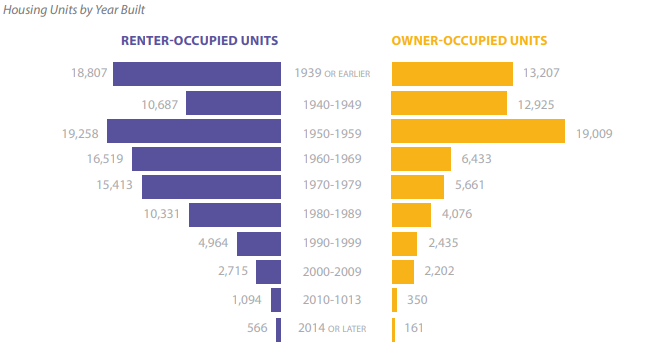
Judging by this graphic, Long Beach has built less housing in the past decade than any other decade in its history.
That hasn’t prevented Garcia from bragging about development though. At the very same meeting where the 2022 Housing Element was presented—which detailed the city’s lack of housing production and lack of affordable housing options, and warned that both have contributed to increased overcrowding, increased displacement, increased prices, increased cost burdens, and more—Garcia celebrated the city’s accomplishments, and claimed that affordable and private developers have worked together with the city to build “significant amounts of housing.”
That’s simply not true.
#ALLHOMESMATTER?
Garcia then went on to defend his questionable filtering theory—despite having just listened to a report which showed how poorly the city is doing with the housing crisis. Garcia said:
“I believe also the research is very clear, which I think tells us that any type of housing development overall helps folks get into housing at all levels of income.”
“The research is very clear”? What research? The research in the very report Garcia is commenting on shows the exact opposite of what he claims. The report even begins by defining its purpose: “The Housing Element describes the current housing conditions in Long Beach and provides data and information on the economic and social stresses that many residents face due to the lack of sufficient access to quality, affordable housing.”
Yet Garcia continued. As part of his long and oblivious statement that touched on absolutely nothing contained in the actual report, he happily claimed, “A unit of housing is good housing.”
Yes, he basically pulled an “All Homes Matter.”
But not all housing is created equal. A 2016 report from the UC Berkeley’s Institute for Policy Government Studies argues that subsidized housing has double the impact on reducing displacement when compared to market-rate units, and that construction of luxury units could actually accelerate rent increases at the neighborhood level. Is Garcia really going to plant his flag on the luxury apartments that are being erected in the city, and claim, “A unit of housing is good housing,” while ignoring all the obvious negative impacts his leadership is having on Long Beach residents?
Furthermore, we also know—even without studies—that building anything in an urban area isn’t like playing a city management video game in sandbox mode. There are limits to time and space. Every single market-rate unit takes up an opportunity that could have gone to an affordable unit. So we can’t approach the housing crisis like a convenient excuse to hand the city to developers and let them build whatever they want. There are opportunity costs. Every plot has to be maximized, every unit optimized—and not for the profits of Garcia’s donor base, or the optics of his social climbing, but in the interests of affordability for Long Beach’s existing tenants.
Despite having failed on that front, Garcia then somehow kept a straight face while claiming, “We know that we need all types of housing in this community, particularly focused of course on housing that is affordable to folks.”
That is a super easy lie to dispense with. If Garcia really believed that affordable housing ought to be the focus—instead of market-rate housing—then why do the city’s issued housing permits show the exact opposite priority? A March 2021 city report included data on housing from 2014 to 2020, and highlighted the following discrepancy:
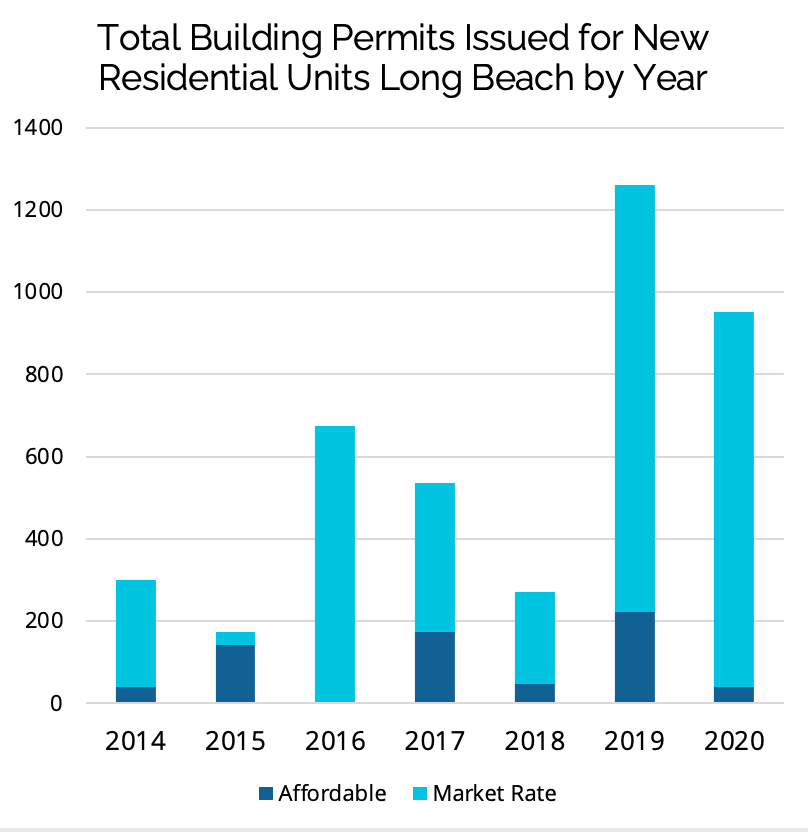
That is Garcia’s vision for Long Beach.
Yet this isn’t the first time Garcia has tried to celebrate accomplishments that haven’t happened. In 2020, we fact-checked Garcia’s false claim that Long Beach had “built and planned 4,000 new affordable and working-class homes,” and we discovered the real numbers:

[READ: Mayor Garcia Keeps Lying—First About Police, Now About Housing]
If I had to guess where the 4,000 number came from, it was Garcia attempting to pretend that literally all of the city’s housing construction, and even its issued permits, and maybe even some numbers that were further down the planning pipeline, could be included together as “working-class homes.” A pretty flagrant lie, especially considering Garcia had already acknowledged to the Long Beach Business Journal years earlier that building market-rate homes was his primary strategy for combating the housing crisis, because, as he put it, “you get folks into those homes which then open up other homes that can be affordable.”
“Other homes that can be affordable,” because clearly market-rate homes aren’t affordable until Garcia needs them to be for a press release.
Since we called him out, Garcia seems to have learned how to better hide his dismal affordable housing numbers. In the 2022 State of the City address, he said, “We have built over 4,700 homes, including affordable apartments…”
Nice and vague.
A 2019 report from the Downtown Long Beach Association said over 800 hotel rooms were expected in the downtown area alone. Meanwhile, the total number of affordable homes permitted across the entire city from 2014—the start of Garcia’s first mayoral term—to 2019 was 626.
Near the end of 2021, the Long Beach Business Journal listed every project under construction, approved, in the city’s pipeline, or even simply proposed. Despite such a wide criteria, they counted roughly 900 affordable units, and over 1,200 hotel rooms.
The obvious con-job involved in making filtering your primary housing strategy helps explain why during Garcia’s tenure Long Beach has built so few affordable homes that even hotel rooms are outpacing them. And, again, try to square these facts with Garcia’s claim at last Tuesday’s council meeting, that the city needs to be “particularly focused of course on housing that is affordable to folks.”
The Housing Element presented to Garcia and the City Council that night also discussed how increased housing costs have increased overcrowding in the city—meaning too many people are living in the same home. Based on our reporting in 2021, certain Long Beach neighborhoods are more overcrowded than even the poorest neighborhoods of New York City, and are perhaps the most overcrowded in the entire nation.
Yes, some Long Beach neighborhoods may be the most overcrowded in the country. Why wasn’t that in Garcia’s recent State of the City address?
[READ: Long Beach has a Major Overcrowding Crisis]
As housing costs continued to rise, Long Beach residents huddled together into crowded conditions to afford their homes. The city’s most marginalized residents have faced these inhumane conditions during a global pandemic caused by an infectious disease, where overcrowding at the household level is a noted factor for COVID’s disproportionate devastation of communities of color.
After all, these are not primarily white neighborhoods trapped in overcrowded conditions, feeling the worst impacts of a housing crisis that Garcia has helped exacerbate with backwards fundraising priorities and backwards ideology. These are largely working-class Latino neighborhoods:
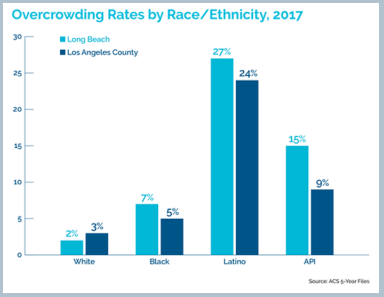
How far can Garcia make it pretending he’s an ally to those he has irreparably harmed?
‘RACIST PLANNING MISTAKES’
Finally, Garcia said at the recent City Council meeting, “I think that we should be supportive of all types of housing all the time.”
“Supportive of all types of housing all the time”? I wish Garcia was telling the truth; because there are already enough factors working against municipalities in the struggle to build housing. We don’t need to add to our list such easily avoidable issues as lies.
Here is a sampling of the problems that can make housing production increasingly difficult at any given moment, in any given city: Supply chains could be disrupted by a global pandemic; the price of lumber could be going up, or the price of other materials, including labor; density restrictions, especially in urban environments, could be forcing developers to build less efficiently than the market would otherwise allow; the complex nature of finding financing for affordable projects can increase time, cost, and labor; developers may themselves be facing nearly prohibitive costs due to the price-tag of the location they want to build on; and, finally, even city staffing and department resources can play a role.
In fact, on that last point, the Housing Element determined that the city “has extensive housing needs that far exceed the City’s financial and administrative capacity, given the City’s current and projected levels of funding and staffing resources.”
Building enough housing in Long Beach—or anywhere else—is going to be difficult. This means leadership and courage are more needed than ever.
Garcia lacks both.
At the Jan. 7, 2020 City Council meeting, Councilmember Rex Richardson proposed to have city staff look into a $298 million affordable housing bond, funded by property taxes, which could eventually be placed on the ballot for voters to decide on for themselves. Richardson’s motion was simply to have city staff begin to do research and bring something back at a later date for the council to then consider. Somehow, even this was too radical for the council, and it failed to pass by a tight 4-5 vote.
Despite over an hour of public testimony in support, Garcia failed that night to vocalize his own thoughts on the bond. While the four councilmembers who voted for the motion argued that the council should at least give voters, and city staff, the chance to figure it out, Garcia never said a word one way or the other. If you ask me, he was keenly aware that a property tax would be very unpopular among the same Long Beach homeowners he had already capitulated to in previous years. Perhaps his influence could have swung the vote the other way, but he didn’t want to stick his neck out. So instead, he kept quiet.
Long Beach still has no dedicated source of funding for affordable housing.
The infuriating truth is that Garcia has contributed to Long Beach’s construction difficulties. Not just by staying silent at a council meeting when the community needed him to speak in defense of funding for affordable housing, but, two years earlier, Garcia did something much more scandalous: He bargained away the city’s housing capacity to protect his own political career.
During the 2018 mayoral race, Garcia cut a secret, backroom deal with what would have been his only major opponent: Robert Fox, a rich, white landlord and single-family zoning advocate. As first reported by Bill Pearl at LBReport.com, Garcia talked Fox out of running against him for mayor, and in exchange promised Fox two things. First, that Garcia would continue to oppose rent control (which he was already opposing anyways); and second, that Garcia would allow Fox and a select number of his friends to make private changes to the city’s new land use map in the final weeks before its approval.
The result of this and other similar transgressions was a map that expanded single-family zoning in the city and reduced multi-family zoning, effectively shrinking Long Beach’s capacity to house people. This is best visualized in a 2018 Beacon Economics report, which showed that one of the final draft versions of the city’s map would result in a net loss of multi-family housing acres, and a lopsided boon to single-family acres. These new single-family acres came at the direct expense of multi-family housing as well as commercial and industrial spaces.
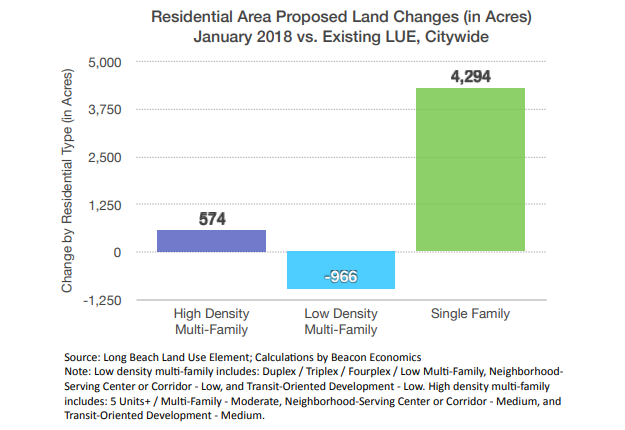
These changes were themselves the result of Garcia capitulating to Long Beach homeowners again and again for over a year. The map’s approval process was continuously delayed, with Garcia’s support, so that a very small, but very powerful, minority of mostly white, propertied Long Beach residents could be appeased. So afraid was Garcia of this particular voting bloc, that city officials organized multiple meetings in wealthy Long Beach neighborhoods so that homeowners could whine and rage and dog-whistle about increased density, with messages like, “high density = high crime.”
These meetings were hugely successful for their cause, and led to hundreds of acres of reductions to the city’s housing capacity. Every time the city released a revised draft of the land use map, it would further reduce density. I went to one of the meetings myself to observe, and it was painful to witness how city staff were being paid to essentially stand on stage and take a public beating from the city’s most privileged residents so that Garcia wouldn’t have to. At that particular meeting, which was attended almost exclusively by white homeowners, and which was set up explicitly to placate them, the city provided free food at public expense.
All this hypocrisy, believe it or not, happened before Garcia struck his deal with Fox. The deal then allowed even further reductions to be made to the city’s land use maps. Those final changes were completed in the last few weeks and days leading up to City Council’s vote to pass the planning document in March 2018—meaning the graphic above doesn’t cover the full extent of the damage Garcia’s lack of leadership and lack of courage has done to Long Beach’s housing capacity.
One month after the map was passed, Garcia was re-elected mayor. Thanks to the deal he struck to keep Fox out of the race, Garcia’s only opponent was a socialist substitute school teacher, whose campaign raised a grand total of $85o. Garcia literally refused to debate him.
A despicable path to victory. All it took was sacrificing the city’s capacity to house people at the altar of white privilege.
Try if you can to square the above facts, detailing Garcia’s cowardly and selfish behavior during an election where he needed to appease single-family zoning advocates, with his public statements when he’s running for Congress and needs to appease progressives. He said in his 2022 State of the City address, “Nothing is more important than building more homes…”
Clearly, “nothing is more important” to Garcia than his own career.
Remember this betrayal, too, when Garcia is peddling the obscenity that he somehow both developed the city and kept it affordable; because the truth is that he both shrunk the city’s potential housing capacity while also making Long Beach unaffordable to an increasing number of its residents.
Even a recent UCLA survey of working papers that were supportive of building market-rate units as part of a cohesive housing strategy, offered the following warning:
“Development can be further problematic if it comes in spite of community resistance to it. While local residents should not have veto power over all development, affluent communities have had tremendous success blocking housing in most U.S. jurisdictions, so to elide similar concerns in less affluent, less white neighborhoods would replicate decades of racist planning mistakes.”
Yet that’s exactly what Garcia did. He tucked his tail in between his legs when confronted with the gesticulations of white, eastside Long Beach residents, and brokered a deal with a rich, white landlord to let him reduce the city’s housing capacity in exchange for an easy re-election campaign. But when faced with the community’s concerns over the Downtown Plan in 2012—and the fact that 24,000 diverse, largely Latino renters would be at risk of displacement if it passed—Garcia bravely stood his ground and denied them any affordability provisions or tenant protections.
Let that be his legacy.
Updated at 9 p.m. Feb. 15, 2022 to reflect that in addition to founding a Republican club at Cal State Long Beach, Mayor Garcia also founded the Long Beach Young Republicans after college.

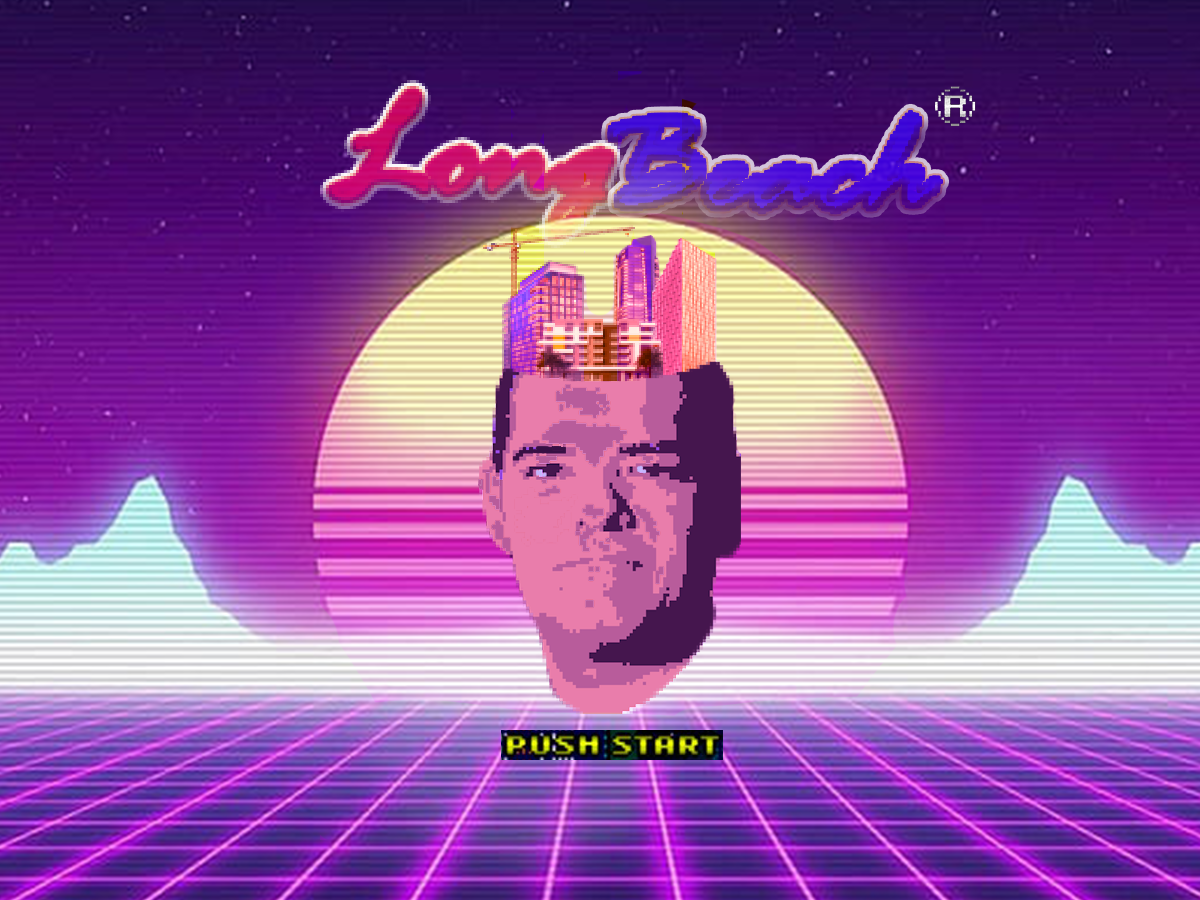
 andrew@forthe.org
andrew@forthe.org


